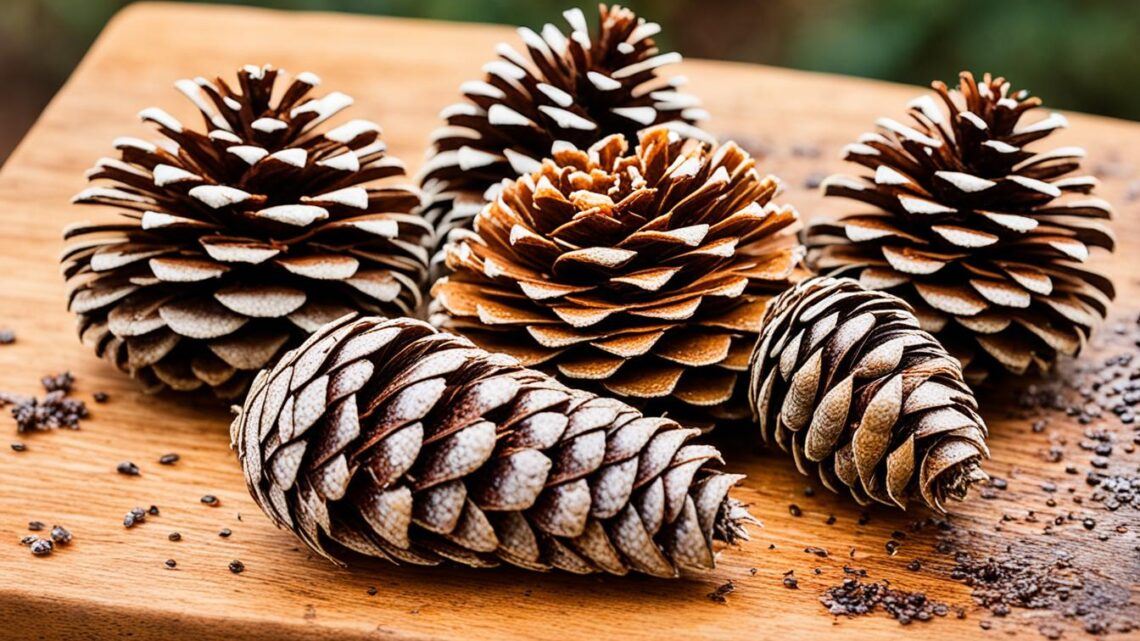
Ever thought about the hidden flavors in pine cones? Learn how to make your own pine cones syrup. This syrup is a unique sweetener that can make your dishes stand out. It’s called Mugolio and comes from the green cones of pine, spruce, and fir trees.
By using these cones, you unlock their natural sugars and flavors. This creates a syrup that takes you on a taste journey through the evergreen woods.
What’s special about pine cones, and how can you use their flavors in your cooking? Explore our guide to learn how to make pine cones syrup. From finding the right ingredients to making a batch that wows everyone, we’ve got you covered.
What is Pine Cones Syrup?
Pine cones syrup, also known as Mugolio, comes from the Italian Alps. It’s made by soaking fresh, young Mugo pine (Pinus mugo) cones in sugar. This method is like making oleo saccharum or the Korean Cheong, where fruits and veggies are used to sweeten syrups.
History and Origin of Mugolio
The name «Mugolio» mixes Italian for Mugo pine tree (Mugo) and oil (olio). It shows the syrup’s roots in the Italian Alps. For years, locals have picked young pine cones to make this syrup. They use the Mugo pine’s natural sweetness and scent.
Making Mugolio is like other flavored syrups, like oleo saccharum and Cheong. The ingredients are soaked in sugar to blend their sugars and flavors. This creates a rich, complex syrup.
Now, Mugolio is loved for its unique taste. It’s like a mix of caramel, pine, and honey. This flavor makes it great for many dishes and drinks.
Foraging for Pine Cones
For making delicious pine cone syrup, it’s important to pick the right cones at the best time. Look for young, green, and unripe cones still on the tree. Avoid the mature, woody cones that have fallen.
The best cones for syrup come from various pine, spruce, fir, and other conifer trees. Think about using ponderosa pine, Scots pine, blue spruce, and balsam fir. These cones are perfect in spring and early summer, when they’re tender and full of flavor.
Sustainable Harvesting Practices
When foraging for pine cones, always follow sustainable practices. This means taking only a few cones from each tree. This way, you help the trees and the ecosystem while still enjoying nature’s gifts.
| Cone Characteristics | Ideal for Syrup Making |
|---|---|
| Size | Average length of 6 inches |
| Maturity | Young, green, and unripe cones |
| Harvest Time | Spring and early summer |
| Conifer Species | Pines, spruces, firs, and other conifers |
By foraging responsibly, you help keep nature healthy and protect the unique flavors for your syrup.
Pine Cones Syrup Varieties
Pine cones syrup comes in many flavors, thanks to different tree species. Pinus cones like ponderosa pine or Scots pine give a resinous taste. Spruce cones make a syrup that’s citrusy and subtle. Balsam fir cones add a resinous flavor with warm spices like cloves and cinnamon.
Cedar cones and juniper berries create unique, aromatic syrups. Young, green tips of pine, spruce, and fir trees can also be used for tasty syrups.
The recipe for pinecone syrup uses about three pounds of brown sugar for a gallon. A serving is just a couple of tablespoons. Making it involves maceration, similar to strawberry juice extraction with sugar.
For a big batch, use a clean gallon jar. Layer green cones with brown sugar and spruce needles. The syrup-making takes weeks as the pinecones soak in sugar to dissolve it. You can flavor the syrup with rice wine vinegar.
Pinecone syrup, or Mugolio, has become more popular in recent years. It originated in the Italian Alps as Mugolio. Pine trees take up to five years to produce cones for syrup. Harvesting is best in early spring, with some urban trees ready by April.
| Cone Type | Flavor Profile |
|---|---|
| Pinus Cones (e.g., Ponderosa Pine, Scots Pine) | Resinous, Assertive |
| Spruce Cones | Subtle, Citrusy |
| Balsam Fir Cones | Resinous, Warm Spices (Cloves, Allspice, Cinnamon) |
| Cedar Cones and Juniper Berries | Unique, Aromatic |
| Pine, Spruce, and Fir Tree Tips | Delicious, Forested-Inspired |
Using different tree species for unripe cones changes the syrup’s flavor. For example, pinus cones make a resinous syrup, while spruce cones offer a citrusy taste. Balsam fir syrups are often considered the tastiest.
The Process of Making Pine Cones Syrup
Ingredients and Equipment
Making pine cone syrup is easy and only needs a few things. You’ll need fresh, green pine cones and sugar, in a 1:2 ratio by weight. Also, get a clean, sterile mason jar or other non-reactive container, a fine-mesh strainer, and be patient.
Step-by-Step Instructions
The best time to pick pine cones is in late spring or early summer. They should be full of moisture, perfect for making syrup. Almost any conifer can be used, but avoid toxic ones like Ponderosa Pine and English yew.
- Collect 10 green pine cones and break or cut them into smaller pieces.
- In a clean mason jar, layer the pine cone pieces and 500g of brown sugar in a 1:2 ratio.
- Seal the jar and put it in a warm spot for at least 4 weeks. The sugar will soak up moisture from the cones, making a sweet syrup.
- During this time, the mix might ferment a bit, which can make the flavor more complex.
- After 4 weeks, strain the mix through a fine-mesh sieve to separate the solids from the syrup.
- Warm the strained syrup to enhance the flavor and make it last longer. Then, bottle it up for later use.
This syrup is great on pancakes, in marinades, or even as a sorbet base. It’s easy to make and adds a unique taste to your cooking. This homemade syrup is a wonderful addition to any kitchen.
Pine Cones Syrup: Versatility and Uses
Pine cones syrup is a versatile ingredient for many dishes. It goes well with vanilla ice cream, pancakes, cocktails, cheeses, and meat glazes. You can drizzle it over fruit, mix it into yogurt or oatmeal, or use it in baked goods.
For savory dishes, use it to glaze meats or add depth to marinades. It also makes sauces and dressings taste unique. This syrup is great with cheeses, adding a special flavor that makes cheese plates better. It can be used in many recipes, from desserts and cocktails to marinades and condiments.
Looking to add a forest flavor to your cooking? Pine cones syrup is a great choice. It’s a unique ingredient that can make your dishes stand out. Try it and see how it can improve your cooking and baking.






